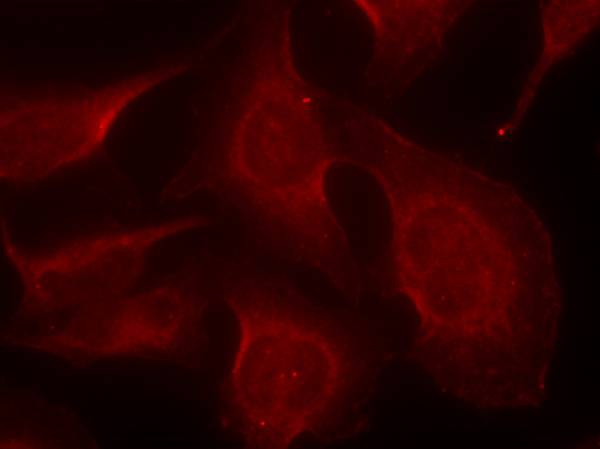

| WB | 咨询技术 | Human,Mouse,Rat |
| IF | 咨询技术 | Human,Mouse,Rat |
| IHC | 1/50-1/100 | Human,Mouse,Rat |
| ICC | 1/100-1/200 | Human,Mouse,Rat |
| FCM | 咨询技术 | Human,Mouse,Rat |
| Elisa | 咨询技术 | Human,Mouse,Rat |
| Aliases | BCL2-like protein 11; BCL2L11; BOD; Bcl-2 related ovarian death protein; |
| Entrez GeneID | 10018; |
| WB Predicted band size | 23kDa |
| Host/Isotype | Rabbit IgG |
| Antibody Type | Primary antibody |
| Storage | Store at 4°C short term. Aliquot and store at -20°C long term. Avoid freeze/thaw cycles. |
| Species Reactivity | Human,Mouse,Rat |
| Immunogen | Peptide sequence around phosphorylation site of serine 69 (P-A-S(p)-P-G) derived from Human BIM. |
| Formulation | Purified antibody in PBS with 0.05% sodium azide. |
+ +
以下是关于BIM(Phospho-Ser69)抗体的3篇参考文献的简要信息:
---
1. **文献名称**:*Phosphorylation of Bim-EL by ERK1/2 promotes its degradation via the proteasome and regulates its pro-apoptotic function*
**作者**:Ley R. et al.
**摘要**:该研究揭示ERK1/2激酶通过磷酸化BIM蛋白的Ser69位点,促进其泛素化降解,从而抑制BIM介导的细胞凋亡。研究利用Phospho-Ser69 BIM抗体验证了这一调控机制在肿瘤细胞耐药性中的作用。
---
2. **文献名称**:*Targeting MCL-1 in cancer: rationale and therapeutic opportunities*
**作者**:Thomas L.W. et al.
**摘要**:文章讨论了MCL-1在癌症中的抗凋亡作用,并指出BIM(Phospho-Ser69)的磷酸化状态可通过抑制其与MCL-1的结合影响凋亡信号。研究通过Western Blot使用该抗体验证了化疗药物对BIM磷酸化的调控。
---
3. **文献名称**:*JNK-mediated phosphorylation of Bim modulates its apoptotic activity in neuronal cells*
**作者**:Putcha G.V. et al.
**摘要**:研究发现JNK信号通路通过磷酸化BIM的Ser69位点增强其促凋亡功能。实验通过Phospho-Ser69 BIM抗体检测神经元损伤模型中BIM的磷酸化水平,揭示了其在神经退行性疾病中的潜在作用。
---
以上文献均涉及BIM(Ser69磷酸化)在凋亡调控中的机制研究,并利用特异性抗体进行功能验证。如需具体文献来源(期刊、年份),可进一步补充数据库检索(如PubMed)。
The BIM (Phospho-Ser69) antibody is a specialized tool used to detect the phosphorylated form of BIM protein at serine 69. a post-translational modification critical in regulating apoptosis. BIM (BCL-2 Interacting Mediator of cell death) is a pro-apoptotic member of the Bcl-2 family that promotes mitochondrial outer membrane permeabilization, triggering caspase activation and programmed cell death. Phosphorylation at Ser69. mediated by kinases such as ERK or AKT in response to survival signals, marks BIM for proteasomal degradation via the ubiquitin-proteasome system. This modification suppresses BIM's pro-apoptotic activity, enhancing cell survival—a mechanism often exploited in cancer cells to evade therapy-induced apoptosis.
The BIM (Phospho-Ser69) antibody is widely utilized in research to study pathways involved in drug resistance, particularly in cancers treated with targeted therapies (e.g., EGFR or BRAF inhibitors). By detecting phospho-BIM levels, researchers assess how survival signaling cascades counteract apoptosis, providing insights into therapeutic failures. Applications include Western blotting, immunohistochemistry, and flow cytometry, enabling the exploration of BIM regulation in contexts like tumor progression, metastasis, and resistance mechanisms. This antibody is pivotal in elucidating cell survival/death balance and developing strategies to overcome treatment resistance in malignancies such as melanoma and lung cancer.
×